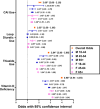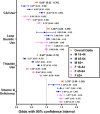Risk of Benign Paroxysmal Positional Vertigo Modified by Diuretics-A Population-Level Case-Control Study
- PMID: 40325935
- PMCID: PMC12379849
- DOI: 10.1002/ohn.1282
Risk of Benign Paroxysmal Positional Vertigo Modified by Diuretics-A Population-Level Case-Control Study
Abstract
Objective: This study aims to characterize diuretic use among patients with and without benign paroxysmal positional vertigo (BPPV) using a population-level database.
Study design: A case-control study.
Setting: TriNetX US Collaborative Network.
Methods: Subjects with ≥1 hospital visit between 2019 and 2024 were queried and stratified by age (18-44, 45-64, and 65+ years) and sex. Each cohort was then divided into those with/without BPPV. Patients with head trauma, middle/inner ear surgery, central vertigo, or migraine were excluded. The prevalence of diuretic use and vitamin D deficiency of each case cohort was compared against the control cohort of the same age/sex using Chi-square analysis. This stratification and analysis were repeated for patients with a vestibular disorder, as well as those with/without Ménière's disease (MD).
Results: Diuretic use was significantly more common in case cohorts than in control cohorts in the general population. In vestibular patients, thiazide and carbonic anhydrase inhibitor (CAI) use were more common in control cohorts, and loop use was less common. In MD patients, thiazide and loop use were more common in control cohorts, and CAI use did not differ significantly. In patients without MD, CAI use also did not differ, while thiazide and loop use were less common in control cohorts.
Conclusion: All diuretics may alter the risk of BPPV. Their influences can be favorable or unfavorable, depending on the individual patient's medical history. Their effects might relate more directly to the efficacy of each diuretic class rather than their specific mechanisms of action.
Keywords: benign paroxysmal positional vertigo; carbonic anhydrase inhibitor; loop diuretic; thiazide diuretic.
© 2025 The Author(s). Otolaryngology‐Head and Neck Surgery published by Wiley Periodicals LLC on behalf of American Academy of Otolaryngology‐Head and Neck Surgery Foundation.
Conflict of interest statement
None.
Figures





Similar articles
-
Prescription of Controlled Substances: Benefits and Risks.2025 Jul 6. In: StatPearls [Internet]. Treasure Island (FL): StatPearls Publishing; 2025 Jan–. 2025 Jul 6. In: StatPearls [Internet]. Treasure Island (FL): StatPearls Publishing; 2025 Jan–. PMID: 30726003 Free Books & Documents.
-
Positive pressure therapy for Ménière's disease or syndrome.Cochrane Database Syst Rev. 2015 Mar 10;2015(3):CD008419. doi: 10.1002/14651858.CD008419.pub2. Cochrane Database Syst Rev. 2015. PMID: 25756795 Free PMC article.
-
Systemic pharmacological interventions for Ménière's disease.Cochrane Database Syst Rev. 2023 Feb 23;2(2):CD015171. doi: 10.1002/14651858.CD015171.pub2. Cochrane Database Syst Rev. 2023. PMID: 36827524 Free PMC article.
-
Dizziness and benign paroxysmal positional vertigo among retirement home residents: a cross-sectional descriptive and interventional study.BMC Geriatr. 2022 Feb 12;22(1):120. doi: 10.1186/s12877-022-02818-w. BMC Geriatr. 2022. PMID: 35151262 Free PMC article. Clinical Trial.
-
Betahistine for symptoms of vertigo.Cochrane Database Syst Rev. 2016 Jun 21;2016(6):CD010696. doi: 10.1002/14651858.CD010696.pub2. Cochrane Database Syst Rev. 2016. PMID: 27327415 Free PMC article.
References
MeSH terms
Substances
LinkOut - more resources
Full Text Sources
Medical

